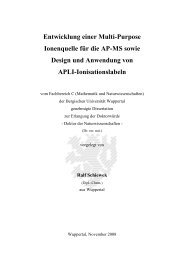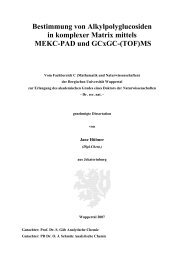The Influence of Oxidative Stress, Carcinogens and Cloning on DNA ...
The Influence of Oxidative Stress, Carcinogens and Cloning on DNA ...
The Influence of Oxidative Stress, Carcinogens and Cloning on DNA ...
Create successful ePaper yourself
Turn your PDF publications into a flip-book with our unique Google optimized e-Paper software.
1.2.6 In-vitro fertilizati<strong>on</strong> (IVF)<br />
11<br />
Introducti<strong>on</strong><br />
Several assisted reproducti<strong>on</strong> technologies (ART) were established to solve the infertility<br />
problems (108) . In vitro-fertilisati<strong>on</strong> (IVF), <strong>on</strong>e <str<strong>on</strong>g>of</str<strong>on</strong>g> the most significant ART had shown success<br />
to c<strong>on</strong>ceive baby in 1976 then the development <str<strong>on</strong>g>of</str<strong>on</strong>g> its exp<str<strong>on</strong>g>and</str<strong>on</strong>g>ed techniques, most importantly<br />
to be cited the intracytoplasmic sperm injecti<strong>on</strong> (ICSI) (109) , had really helped the infertile<br />
couples to c<strong>on</strong>ceive infants. However, different birth defects (110, 111) had been remarked in<br />
some cases like chromosomal abnormalities, cardiovascular defects, growth abnormalities (112,<br />
113) as well as high risk <str<strong>on</strong>g>of</str<strong>on</strong>g> low birth weight. Hansen et al (114) had declared that the babies c<strong>on</strong>-<br />
cieved by IVF have twice the rate to develop major birth defects as compared to naturally<br />
c<strong>on</strong>ceived children. Additi<strong>on</strong>ally, IVF was reported to be associated with diseases like An-<br />
gelman syndrome (AS) (115) <str<strong>on</strong>g>and</str<strong>on</strong>g> Beckwith-Wiedemann syndrome (BWS) (116, 117) that etiologically<br />
related to aberrant genomic imprinting (118, 119) . <str<strong>on</strong>g>The</str<strong>on</strong>g> epigenetic modificati<strong>on</strong>s <str<strong>on</strong>g>of</str<strong>on</strong>g> the ge-<br />
nome including <strong>DNA</strong> methylati<strong>on</strong> <str<strong>on</strong>g>and</str<strong>on</strong>g> hist<strong>on</strong>e modificati<strong>on</strong> are linked through their functi<strong>on</strong>s<br />
<str<strong>on</strong>g>and</str<strong>on</strong>g> synchr<strong>on</strong>ously affecting each other. <strong>DNA</strong> methylati<strong>on</strong> as an important factor in modeling<br />
the structural patterns <str<strong>on</strong>g>of</str<strong>on</strong>g> genome was investigated in IVF in different studies. Different me-<br />
thylati<strong>on</strong> status was reported (120, 121) depending <strong>on</strong> the protocol <str<strong>on</strong>g>of</str<strong>on</strong>g> in vitro embryo formati<strong>on</strong><br />
as well as tissue specificity (120) . IVF could affect the <strong>DNA</strong> methylati<strong>on</strong> via imprinting errors<br />
that happened during this in vitro reproducti<strong>on</strong> technique (122, 123) .<br />
1.2.7 <str<strong>on</strong>g>Cl<strong>on</strong>ing</str<strong>on</strong>g><br />
Somatic cell nuclear transfer (SCNT), or cl<strong>on</strong>ing, is a technique used to create genetically<br />
identical animals by somatic cell nuclear transfer into unfertilized eggs. In this technique, the<br />
nuclear genetic material is transferred from the animal that should be cl<strong>on</strong>ed (known as genetic<br />
d<strong>on</strong>or) into a recipient cell matured oocyte or unfertilised egg (cytoplast) from which the<br />
genetic material has been removed. <str<strong>on</strong>g>The</str<strong>on</strong>g>n, the somatic cell taken from genetic d<strong>on</strong>or is inserted<br />
into the enucleated egg <str<strong>on</strong>g>and</str<strong>on</strong>g> the fusi<strong>on</strong> <str<strong>on</strong>g>of</str<strong>on</strong>g> two cells is accomplished by electricity. <str<strong>on</strong>g>The</str<strong>on</strong>g><br />
fused egg is activated for the reproducti<strong>on</strong>. <str<strong>on</strong>g>The</str<strong>on</strong>g>n the activated egg is placed in a culture medium.<br />
<str<strong>on</strong>g>The</str<strong>on</strong>g> cellular divisi<strong>on</strong> is watched till an early-stage embryo (blastocyst) is formed <str<strong>on</strong>g>and</str<strong>on</strong>g><br />
then is transferred to a recipient female (sometimes referred to as ’surrogate mother’) for the<br />
subsequent development (124) .




